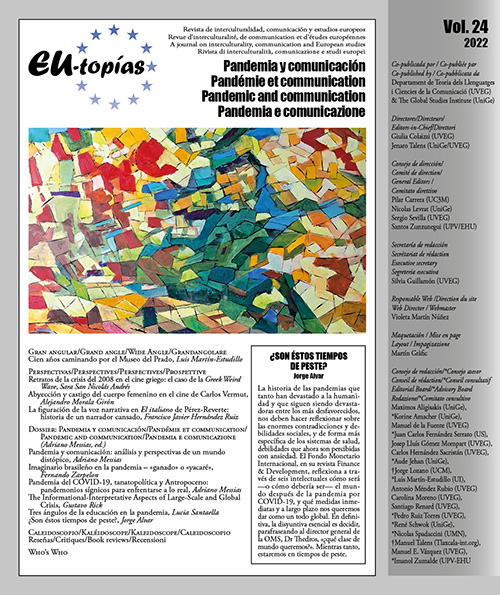Abjection and female body punishment on Carlos Vermut’s cinema
DOI:
https://doi.org/10.7203/eutopias.24.25546Keywords:
Abjection, female body, filmic representation, Carlos Vermut Abstract
Abstract
The aim of this research paper is to analyse the representation of female bodies in three movies by director Carlos Vermut: Diamond Flash (2011), Magical Girl (2014) and Quién te cantará (2018). By applying an interdisciplinary perspective combining semiotics and feminist film theory, we study the modes of identification related to women’s main characters. Textual analysis allows us to conclude that in Vermut’s fiction women are condemned to live an abject corporeality, forced to choose between identity reinvention or death.
 Downloads
Downloads
 References
References
Aparicio, Enrique. «Carlos Vermut: “Nuestra identidad se construye modificando aquello que imitamos”». Academia: Revista del Cine Español, 233, 2018, pp. 20-23.
Aumont, Jacques y Marie, Michel. Análisis del film. Barcelona: Paidós, 1990.
Baecque, Antoine. «Al acecho: ¿qué queda de la política de los autores?». Coord. Antoine de Baecque. La política de los autores. Manifiestos de una generación de cinéfilos. Barcelona: Paidós, 2003, pp. 170-178.
Bettetini, Gianfranco. Producción significante y puesta en escena. Barcelona: Gustavo Gili, 1977.
Butler, Judith. El género en disputa. Barcelona: Paidós, 2018.
Carmona, Ramón. Cómo se comenta un texto fílmico. Madrid: Cátedra, 2020.
Casetti, Francesco y Di Chio, Federico. Cómo analizar un film. Barcelona: Paidós, 2007.
Casetti, Francesco. Teorías del cine. Madrid: Cátedra, 2010.
Clément, Catherine y Kristeva, Julia. Lo femenino y lo sagrado. Madrid: Cátedra, 2000.
Colaizzi, Giulia. La pasión del significante. Madrid: Biblioteca Nueva, 2007.
Company, Juan Miguel, ed. Máscaras de la carne. Aproximaciones al cine de Ingmar Bergman (1918-2018). Valencia: Shangrila, 2018.
Costa, Jordi. «Niña de fuego y hielo». El País, 16 de octubre de 2014. <https://elpais.com/cultura/2014/10/16/actualidad/1413476444_494503.html> (20-06-2022).
Doane, Mary Ann. Femmes Fatales. Nueva York: Routledge, 1991.
De Lauretis, Teresa. Alicia ya no. Madrid: Cátedra, 1992
Gaudreault, André y Jost, François. El relato cinematográfico. Barcelona: Paidós, 1995.
Guillamón, Silvia. Desafíos de la mirada. Feminismo y cine de mujeres en España. Valencia: Institut Universitari d’Estudis de la Dona, 2015.
Guillamón, Silvia. «La representación de la femme fatale en el universo narrativo de Muerte de un ciclista (Juan Antonio Bardem, 1955)». Área Abierta. Revista de comunicación audiovisual publicitaria, 17 (3), 2017, pp. 313-331. http://dx.doi.org/10.5209/ARAB.55802
Heredero, Carlos Fernández. «SAN SEBASTIÁN 2018 en tiempo real». Caiman, 22 septiembre de 2018. <https://www.caimanediciones.es/san-sebastian-2018/> (20-06-2022).
Kristeva, Julia. Poderes de la perversión. Buenos Aires: Siglo XXI, 1988.
Marks, Laura. The Skin of the Film: Intercultural Cinema, Embodiment, and the Senses. Durham: Duke University Press, 2000.
Martínez, Luis. «Quién te cantará: el universo perfecto de Carlos Vermut». El Mundo, 31 de octubre de 2018. <https://www.elmundo.es/metropoli/cine/2018/10/25/5bd09625e2704ea8498b4638.html> (20-06-2022)
Marzabal Albaina, Iñigo. «Cuerpo, identidad y violencia (en un cierto cine contemporáneo)», EU-topías, 9, 2015, pp. 139-147.
Marzal, Javier y Gómez-Tarín, Francisco Javier. «Interpretar un film. Reflexiones en torno a las metodologías de análisis del texto fílmico para la formulación de una propuesta de trabajo». Eds. Benavides, Juan, David Alameda y Elena Fernández Blanco. Nuevos temas de comunicación. Madrid: Universidad Complutense de Madrid, 2006, pp. 393-415.
Merás, Lidia. «El vínculo mortal. La relación madre-hija en Quién te cantará (Carlos Vermut, 2018)», Fotocinema. Revista Científica de Cine y Fotografía, 22, 2021, pp. 373-396.
Mulvey, Laura. Placer visual y cine narrativo. Valencia: Universitat de València, Centro de Semiótica y Teoría del Espectáculo, 1988.
Ontoria-Peña, Mercedes. «Es imposible que vuelva a ser esa mujer»: cuerpo e identidad en Quién te cantará», L’Atalante. Revista de estudios cinematográficos, 31, 2021, pp. 225-236.
Ordóñez, Marcos. «Cine realmente underground II: “Diamond Flash” (Carlos Vermut, 2011)». El País, 2 de marzo de 2012. <https://blogs.elpais.com/bulevares-perifericos/2012/03/cine-realmente-underground-ii-diamond-flash-carlos-vermut-2011-diamond-flash-primer-largometraje-de-carlos-vermut.html> (20-06-2022).
Rodríguez Valls, Francisco. «El Frankenstein de Mary Shelley (1797-1851)», Thémata. Revista de Filosofía, 44, 2011, pp. 473-484.
Shelley, Mary. Frankenstein. Madrid: El País, 2004.
Venet Gutiérrez, Jacqueline. No hay tanto pan cine español en tiempos de crisis (2007-2016). Meditaciones en torno a los jóvenes. Magical girl y Hermosa juventud. Zaragoza: Universidad de Zaragoza, 2018.
Venet-Gutiérrez, Jacqueline y Rubira-García, Rainer. «Un ladrón asalta el vacío del cuadro. Traspasos y promiscuidad discursiva en la obra gráfica y fílmica de Carlos Vermut», Neuróptica. Estudios sobre el cómic, 2, 2020, pp. 177-194.
Zecchi, Barbara. La pantalla sexuada. Madrid: Cátedra, 2014.
Zunzunegui, Santos. La mirada cercana. Microanálisis fílmico. Barcelona: Paidós, 1996.
Downloads
Published
How to Cite
-
Abstract605
-
PDF (Español)292
Issue
Section
License
![]()
The authors conserve the copyright. All content published in EU-topías. Journal of interculturality, Communication, and European Studies are subject to the license Creative Commons Attribution-NonCommercial-ShareAlike 4.0 license. The full text of the license can be found at <http://creativecommons.org/licenses/by-nc-sa/4.0>
They may be copied, used, disseminated, transmitted and publicly displayed, provided that:
- The authorship and original source of the publication is cited (journal, publisher and URL of the work).
- They are not used for commercial purposes.
- The existence and specifications of this license of use are mentioned.
It is the responsibility of the authors to obtain the necessary permissions for images that are subject to copyright.



